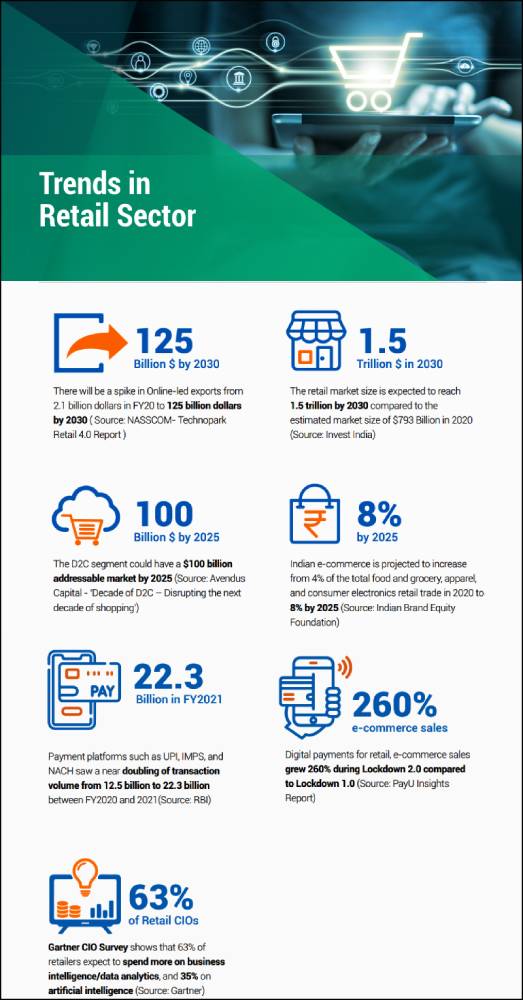
Key points from the e-book on Retail sector trends in India authored by Anuj Vaid, Executive Director, CMS IT Services:
January 6 2022: The new millennium breathed new life into India’s retail sector. An Increase in aggregator companies, better FDI policies, fintech investments and the self-reliant manufacturing of products are some of the ways the industry’s growth is being augmented.
-Omnichannel assistance that combines the traits of both online and offline buying experiences, will become mainstream and amplify online-led exports
-Beacon technology and interest tracking can lead to customers receiving personalized suggestions when in proximity to a brand’s physical location
-Self Service Technologies (SSTs) liked Smart Vending Machines, Order Kiosks etc are set to create seamless experiences for customers at physical stores by making service transactions quicker, more convenient, and accurate
-Fintech and digital payments, in general, have taken the retail industry by storm and will continue to make buying and selling a hassle-free affair in a post-pandemic world with their attractive ‘low-contact’ systems
-Digitization will take over the entirety of back-end operations and revolutionize inventory management, enterprise scheduling and employee management
-Unmanned Aerial Vehicles (UAV) like Drones will speed up the delivery and distribution of retail goods
-Retail chains will implement Gamification via apps, social media, QR codes etc in their physical and online stores to heighten shopping experience, track real-time purchase behaviour etc
-Predictive Analytics tools will become more readily available to all D2C outlets regardless of size and enhance personalization, sales forecasts etc.
| -Value-driven consumption that is more environmentally conscious and ethical to all stakeholders, will take over the buying pattern
-Smaller retailers have kickstarted their digital journey thanks to the pandemic, but the expertise and budget required to move forward is much higher than what is currently afforded to them
-The ‘Human Touch’ is still very much desired by a majority of the older customer demographic and a shift to an impersonal, completely digital-led experience may not satisfy customers and retain loyalty
Brick and mortar isn’t going away any time soon. At least for the next decade, retailers will continue to focus on and leverage a judicious blend of both - the physical and digital infrastructure. The two modes will complement - not supplement - each other and bring together the best of the virtual and the physical worlds to create a delightful customer experience.
Enabling Technologies
The debate has shifted from offline vs. online to direct to consumer (D2C) models and technology for efficient distribution and last-mile delivery.
-Point-of-Sale Integration via SaaS Cloud-based ERP Solutions can make or break the synchronisation of both the digital and physical domain’s inventory, payments etc
-AI/ML-driven big data and Vertical SaaS insights have become instrumental in elevating customer experience, forecasting demand, and hiking overall sales
-Virtual Trial Rooms, Smart Mirrors, Interactive Interfaces, 3D feature-analysis etc leveraging AR/VR technologies will enhance user[1]experience
- IoT networks will reduce human interactions in ‘Just Walk Out Stores’ that will auto-collect payments.|-A combination of Conversational AI, NLP, Augmented and Virtual Realities can create virtual or robotic ‘salespeople’ who can shorten the buying cycle by providing targeted solutions |-Hyper automation will drive up supply chain efficiencies, improve inventory management and product delivery, distribution, and tracking. |-Customer data tracking and payment portals will become more secure with cross-platform Customer Data Integration (CDI) and encryption
Challenges
An essential part of the digital retail experience involves collecting customer data – emails, phone numbers, card information etc. This raises data privacy, transparency, and cybersecurity concerns regarding online transactions.
Read our main report here
The full retail sector CMS study in PDF here